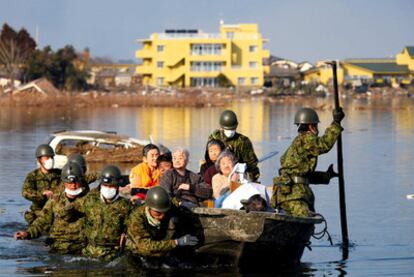Emergency situation lifted after region braces for tsunami impact
Pacific coast nations had time to test their alert procedures before waves hit
The emergency situation that was imposed in virtually all countries up and down the Pacific coast of Latin America was lifted nearly 30 hours after the tsunami waves began rippling across the ocean from the 8.9-magnitude earthquake that hit Japan last Friday. The threat brought anxiety and fear to the region as a whole, but especially Chile, which is still picking itself up from a devastating quake last year in which more than 700 were killed.
Tsunami waves that eventually reached the western hemisphere were varied in strength, but they didn't cause any serious damage or cause large numbers of casualties. This factor is being attributed not only to the progressive weakening of the waves, but also to the quick reaction by governments, which implemented emergency measures as soon as news of the earthquake came through.
In Peru, the government cancelled classes in all schools in towns and cities along the coast, including the capital Lima.
Chilean President Sebastián Piñera ordered the evacuation of the estimated 3,200 residents of Easter Island and moved them to higher ground near the airport.
In Quito, Ecuadorian President Rafael Correa issued "a state of alert" and also ordered the evacuation of some coastal areas. Similar measures were taken in Nicaragua by President Daniel Ortega's government.
Attention is now focused on the situation at the Japanese nuclear power plants. Newscasts throughout the region are starting to compare them with reactors that are dotted throughout Argentina and Brazil and warn that similar radioactive leaks could occur if a quake struck in the vicinity.
The tragedy that has hit Japan is also being shared in South America, where several countries are home to large Japanese communities. In Brazil, 1.6 million people are of Japanese origin - the largest Japanese population outside the Asian country. In Peru, where Alberto Fujimori, a Japanese-Peruvian, once governed, more than 100,000 people are of Japanese descent. His daughter Keiko is running in April's presidential elections.
In economic terms, the Japanese crisis is also being examined very carefully by Latin American newspapers though, with the exception of Mexico, the region receives a small proportion of Japanese direct foreign investment.
The consequences of the Japanese tsunami can be seen in the traditional fishery industry, which experts say will be hard hit. Many boats were damaged or sunk, and the destruction is particularly serious in the port of Santa Rosa, Ecuador, where hundreds of families desperately tried for hours to save their crafts.
The Galapagos Islands, which belong to Ecuador and are famous for their unique ecosystem, were damaged after being hit by waves up to 2.5 meters in height that affected some important turtle-nesting areas. But experts say there is chance for recovery.
The long delay between the Japanese tsunami and the arrival of the main wave (which traveled more than 14,500 miles in 16 hours to the Galapagos, and 19 hours to the coastal areas) provided an opportunity to test the emergency procedures in all countries concerned. In Chile, which suffered a devastating earthquake and tsunami itself in February 2010, the government said that all alarms were activated, and President Piñera spent much of the night at the National Emergency Office.
In Colombia there was an "abnormal situation" in the sea on some beaches and fishing villages, but the president, Juan Manuel Santos, said the damage was not significant.

Tu suscripción se está usando en otro dispositivo
¿Quieres añadir otro usuario a tu suscripción?
Si continúas leyendo en este dispositivo, no se podrá leer en el otro.
FlechaTu suscripción se está usando en otro dispositivo y solo puedes acceder a EL PAÍS desde un dispositivo a la vez.
Si quieres compartir tu cuenta, cambia tu suscripción a la modalidad Premium, así podrás añadir otro usuario. Cada uno accederá con su propia cuenta de email, lo que os permitirá personalizar vuestra experiencia en EL PAÍS.
¿Tienes una suscripción de empresa? Accede aquí para contratar más cuentas.
En el caso de no saber quién está usando tu cuenta, te recomendamos cambiar tu contraseña aquí.
Si decides continuar compartiendo tu cuenta, este mensaje se mostrará en tu dispositivo y en el de la otra persona que está usando tu cuenta de forma indefinida, afectando a tu experiencia de lectura. Puedes consultar aquí los términos y condiciones de la suscripción digital.
Últimas noticias
Reinhard Genzel, Nobel laureate in physics: ‘One-minute videos will never give you the truth’
Pinochet’s victims grapple with José Antonio Kast’s rise in Chile
How Japan is trying to avert ‘digital defeat’
The complicated life of Francesca Albanese: A rising figure in Italy but barred from every bank by Trump’s sanctions
Most viewed
- Pablo Escobar’s hippos: A serious environmental problem, 40 years on
- Why we lost the habit of sleeping in two segments and how that changed our sense of time
- Charles Dubouloz, mountaineering star, retires at 36 with a farewell tour inspired by Walter Bonatti
- Trump’s obsession with putting his name on everything is unprecedented in the United States
- The Florida Keys tourist paradise is besieged by immigration agents: ‘We’ve never seen anything like this’








































